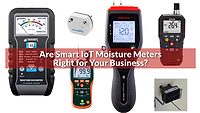Right Tools, Right Measurements
Finding the right tools for quickly and accurately testing moisture content








In restoration and remediation work, contractors are typically called on to deal with the worst-case scenario. Whether you’re working on a place of business or a private residence, the health and safety of the occupants relies on your ability to swiftly assess and thoroughly remediate water damage to prevent further damage to the structure, the growth of mold, and other issues that can be caused by moisture.
Making fast, accurate assessments of the moisture conditions inside a structure requires having the right tools for testing the moisture content of the various building materials inside the structure such as walls, wallboard, wood, insulation, and flooring elements.
For moisture damage restoration and remediation work, moisture meters and thermo-hygrometers are indispensable tools. With the right kind of moisture testing device, you can:
- Quickly identify moisture hot spots;
- Define which areas in a structure are affected by moisture;
- Confirm whether the environment is suitable for drying;
- Identify what kind of drying equipment is best for the job;
- Monitor overall progress of dryout efforts;
- Verify the structure is dry before removing any equipment.
The three major types of devices contractors can use to track moisture conditions in a building are pinless moisture meters, pin-type moisture meters, and thermo-hygrometers. Each of these three devices has a different use in water damage remediation and restoration work.
Using Pinless Moisture Meters
One of the key characteristics of a pinless moisture meter of any kind is its ability to get moisture content readings in large, flat objects quickly. All a contractor has to do to get a reading is press the meter’s scanning plate against a flat surface and activate the meter.
Within a second, the meter will give the user a reading of the moisture content of the material within the meter’s scanning area, and the user can then lift the meter and take another reading elsewhere. This functionality allows contractors dealing with restoration work to quickly scan large areas with flat surfaces (such as floors or walls) to determine the presence of moisture pockets.
The major limitation of pinless moisture meters is that they require a flat scanning surface that is thick enough to accommodate the meter’s scanning depth to provide accurate readings. If the surface is not flat or is too thin, then the reading results will be thrown off.
Using Pin-Type Moisture Meters
Where pinless meters check moisture across the whole area of their scanning plate, pin-type meters test for moisture between two or more contact pins that the user physically inserts into the material being tested.
Contractors can take advantage of the pinpoint accuracy of a pin meter’s testing area to check the depth at which a moisture pocket occurs in solid materials such as wood. After finding a moisture pocket with a pinless meter, a contractor can check the site with a pin meter, pushing the pins in little by little and taking a reading every 1/8” or 1/4” to determine how deep within the material the moisture resides.
Also, pin meters are perfectly capable of taking accurate readings in irregularly shaped objects that pinless meters cannot scan easily. This allows you to check for moisture intrusion in small decorative items as well as furniture.
Many pin-type meters can be fitted with optional probes to check for moisture in insulation or behind walls. For example, a hammer probe can be used to check flooring or even get a reading in subfloors.
The major drawbacks to pin meters are that they cannot cover large areas quickly, and they leave pinholes in the material at the test site. Contractors often carry both pin and pinless meters to gain the benefits of both.
Using Thermo-Hygrometers for Restoration
Unlike pin and pinless moisture meters, thermo-hygrometers don’t give users a %MC reading in a specific building material. Instead, these devices provide a reading of the ambient moisture conditions in an area.
One of the key uses of these devices in water damage restoration and remediation work is to check the ambient moisture levels in rooms throughout the structure and in the area surrounding the structure to establish what the building’s equilibrium moisture content should be.
Continuing to use thermo-hygrometers throughout your water damage restoration work can provide a reliable litmus test of how dryout operations are progressing.
Saving Time and Money with the Right Tools
When you combine the use of pin meters, pinless meters, and thermo-hygrometers throughout your water damage remediation process, you can save valuable time identifying the areas of the structure most in need of work.
By increasing the efficiency of your dry out operations, you can save money on labor that otherwise would be spent working in areas where it wouldn’t do the most good. Furthermore, recording your reading results can help you prove the necessity of your dry out and restoration efforts, which can help the property owner secure the insurance money needed to pay your bill.
Having the right tool for the job is paramount to providing a top-notch restoration service and building your reputation, while helping you become faster and more efficient. In short, moisture meters and thermo-hygrometers are among the best investments that restoration contractors can make in their business.
Looking for a reprint of this article?
From high-res PDFs to custom plaques, order your copy today!










